Related Research Articles

Propalaeotherium was an early genus of equid endemic to Europe and Asia during the Early Eocene.
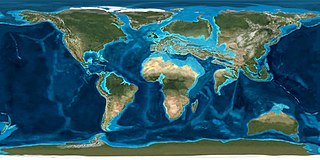
In the geologic timescale the Ypresian is the oldest age or lowest stratigraphic stage of the Eocene. It spans the time between 56 and47.8 Ma, is preceded by the Thanetian age and is followed by the Eocene Lutetian age. The Ypresian is consistent with the lower Eocene.
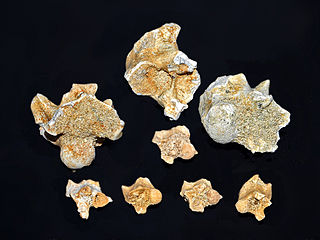
Palaeophis is an extinct genus of marine snake that is the type genus of the extinct snake family Palaeophiidae.

The Eocene–Oligocene extinction event, the transition between the end of the Eocene and the beginning of the Oligocene, is marked by large-scale extinction and floral and faunal turnover. Most of the affected organisms were marine or aquatic in nature. They included the last of the ancient cetaceans, the Archaeoceti.
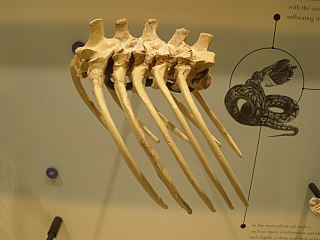
Madtsoiidae is an extinct family of mostly Gondwanan snakes with a fossil record extending from early Cenomanian to late Pleistocene strata located in South America, Africa, India, Australia and Southern Europe. Madtsoiid snakes include very primitive snakes, which like extant boas and pythons would likely dispatch their prey by constriction, such as Gigantophis, one of the longest snakes known at an estimated 10.7 metres (35 ft), and the Australian Wonambi and Yurlunggur. As a grouping of basal forms the composition and even the validity of Madtsoiidae is in a state of flux as new pertinent finds are described.
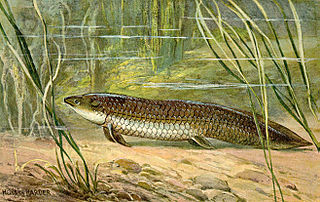
Ceratodus was a wide-ranging genus of extinct lungfish. Fossil evidence dates back to the Early Triassic. A wide range of fossil species from different time periods have been found around the world in places such as the United States, Argentina, Greenland, England, Germany, Egypt, Madagascar, China, and Australia. Ceratodus is believed to have become extinct sometime around the beginning of the Eocene Epoch. The closest living relative of Ceratodus is thought to be the Queensland lungfish, Neoceratodus forsteri, which means "new Ceratodus" in Greek.
Lukas Hottinger was a paleontologist, biologist and geologist. Hottinger collaborated with the Natural History Museum of Basel (Switzerland).
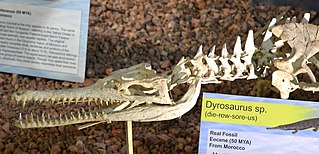
Dyrosaurus is a genus of extinct crocodylomorph that lived during the early Eocene. The name Dyrosaurus comes from sauros (σαῦρος) the Greek for lizard or reptile, and Dyr for Djebel Dyr (mountain) close to where the type species was discovered.
Paleontology or palaeontology is the study of prehistoric life forms on Earth through the examination of plant and animal fossils. This includes the study of body fossils, tracks (ichnites), burrows, cast-off parts, fossilised feces (coprolites), palynomorphs and chemical residues. Because humans have encountered fossils for millennia, paleontology has a long history both before and after becoming formalized as a science. This article records significant discoveries and events related to paleontology that occurred or were published in the year 1992.

Iberosuchus is a genus of extinct sebecosuchian mesoeucrocodylian found in Western Europe from the Eocene. Remains from Portugal was described in 1975 by Antunes as a sebecosuchian crocodilian. This genus has one species: I. macrodon. Iberosuchus was a carnivore, unlike the crocodilians today, they are not aquatic and are instead terrestrial.
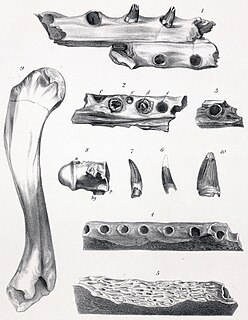
Dollosuchus is an extinct tomistomine originally named as a species of Gavialis. It is a basal form possibly related to Kentisuchus, according to several phylogenetic analyses that have been conducted in recent years, and is the oldest known tomistomine to date. Fossils have been found from Belgium and the United Kingdom. It had large supratemporal fenestrae in relation to its orbits, similar to Kentisuchus and Thecachampsa.
Djebelemur is an extinct genus of early strepsirrhine primate from the late early or early middle Eocene period from the Chambi locality in Tunisia. Although they probably lacked a toothcomb, a specialized dental structure found in living lemuriforms, they are thought to be a related stem group. The one recognized species, Djebelemur martinezi, was very small, approximately 100 g (3.5 oz).

Cynohyaenodon is an extinct paraphyletic genus of hyaenodontid mammal that lived during the early to middle Eocene in Europe.

The Lignites de Soissonais is a geologic formation in the Var, Marne departments of France. It preserves fossils dating back to the Ypresian stage of the Eocene period.

The Quercy Phosphorites Formation is a geologic formation and Lagerstätte in Occitanie, southern France. It preserves fossils dating back to the Paleogene period, or MP16 to MP28 zones of the European land mammal age classification, ranging from approximately 38 to 25 Ma.

Callista is a genus of saltwater clams, marine, bivalve molluscs in the family Veneridae, the venus clams.
Cyclocardia elegans is an extinct species of clam in the family Carditidae.

Eocithara is an extinct genus of sea snails, marine gastropod mollusks, in the family Harpidae.

Peradectes is an extinct genus of small metatherian mammals known from the Cretaceous and Paleocene of North and South America through the Eocene of North America and parts of Europe. The first discovered fossil, P. elegans, was one of 15 Peradectes specimens described in 1921 from the Mason pocket fossil beds in Colorado.
References
- Une nouvelle espèce de Digitolabrum (Gastropoda: Littorinimorpha: Rostellariidae) dans l’Éocène moyen du Bassin d’Aquitaine. Pacaud J.M., Ledon D. and Caze B., Cossmanniana, volume 13, pages 33–47, 2011
- Cuvillier (J.), 1930 - Révision du Nummulitique égyptien. Mémoires de l'Institut d'Egypte, t. 16, p. 1-372